suicide barrier update

-
*In October 2005, JAMA published the most complete review ever undertaken of suicide prevention techniques. Twenty-three physicians and scientists from the US, Europe, and Asia authored the review after carefully studying forty years of published scientific research. They concluded that restricting access to lethal means is one of only two scientifically established methods to reduce suicides.
-
*Remember the phrase "go stick your head in the oven"? It comes from a time in Great Britain when cooking gas had a high concentration of poisonous carbon monoxide. As a result, there were many suicides by carbon monoxide poisoning. When Great Britain changed to the low carbon monoxide content cooking gas we use today, the national suicide rate dropped by 26%.
-
*Use of some prescription and over-the-counter drugs has been a means of suicide for many years. However, as the availability of these drugs changes, so does the number of suicides. In Australia, suicide from sedative overdose increased when the drugs were easier to get and declined when access was restricted. In the UK, limiting access to an over-the-counter drug by simply shifting from bulk packaging to small-unit packaging reduced suicides.
-
*Suicide is an impulsive act and lives can be saved when a suicidal person gets past the impulse. One study in Texas looked at 153 cases of near-lethal suicide attempts. Researchers found that 24% of these individuals spent less than 5 minutes between the decision to commit suicide and the attempt. A study of 54 bridge suicides in Montreal found that 44 of the individuals had experienced recent personal problems. Another study of suicides in the Montreal subway found that 100 of the 129 individuals studied had an adverse life event within two weeks of the death. Cognitive tests for impulsivity and impaired decision-making consistently show higher scores for suicidal individuals than controls in national studies.
-
*Dr. Richard Seiden of UC Berkeley's School of Public Health investigated the lives of more than 500 people removed from the Golden Gate Bridge as they were about to jump. He found that, for an average of 26 years after the suicide attempt, 94% of these people were either still living or had died of natural causes. Twenty-eight people are known to have jumped from the Golden Gate Bridge and lived. Of these, only two are known to have subsequently committed suicide.
-
*When a suicide barrier was erected on the Ellington Bridge in Washington, D.C., there was no increase in suicides from the nearby Taft Bridge because the Taft Bridge railing is CHEST HIGH (and of course suicides from the Ellington were stopped).
-
*Professor Marc Daigle of the University of Quebec published an article in 2005 titled Suicide Prevention Through Means Restriction. It asserted that: (1) suicides can be impulsive, particularly among young people, (2) individuals have a preference for a specific means of suicide, and (3) if means are restricted they may not go elsewhere.
Suicides From Bridges Are Not Just a Bay Area Problem
They Are a National Problem
Here are just a few of the many other bridges in the United States alone with the dubious distinction of being suicide magnets:
All-American Bridge, Akron, OH
Aurora Bridge, Seattle, WA
Benicia-Martinez Bridge, Martinez, CA
Cold Spring Canyon Bridge, Santa Barbara, CA
Coronado Bridge, San Diego, CA
New River Gorge Bridge, Fayetteville, WV
Perrine Bridge, Twin Falls, ID
Piscataqua River Bridge, Portsmouth, NH
Rio Grand Gorge Bridge, Taos, NM
Sunshine Skyway Bridge, St. Petersburg, FL
Tappan Zee Bridge, Tarrytown, NY
Varrazano-Narrows Bridge, Staten Island, NY
When Will the Suicide Barrier Be Built?
The Golden Gate Bridge, Transportation and Highway District voted 14:1 in October, 2008 in favor of installing a suicide net on both sides of the Golden Gate Bridge, subject to obtaining funding. Because of the magnitude of the project ($40 - $50 million), the only viable source of funding is the U.S. Government. The barrier project would not qualify for stimulus funds from the Obama Administration because it is not yet “shovel ready”. It also does not qualify for funding under the U.S. Highway Bill. Further environmental and engineering feasibility studies are currently ongoing, and there do not appear to be any major hurdles to that project.
Since January, 2009, an alliance of concerned citizens - including people who’ve lost loved ones to the bridge, the mental health community, GGB Board staff and representatives from State Assemblyman Tom Ammiano’s office, have been working together on a funding strategy. The strategy is simple in concept: amend the language in the U.S. Highway Bill to allow for funding of “suicide deterrent systems” on bridge structures in the U.S. so that we can apply for funding under the Bill. Congresswoman Lynn Woolsey (D-CA) has undertaken to sponsor this proposed amendment (see below). Co-signing the bill were our great Congressional representatives from Northern California: Nancy Pelosi, Ellen Tauscher, Barbara Lee, Jackie Speier, Mike Thompson, Anna Eshoo, Mike Honda and Zoe Lofgren; from California’s Central Coast Sam Farr; from Southern California Laura Richardson, Diane Watson, Xavier Becerra and Maxine Waters; and from Chicago Jesse Jackson, Jr..
Despite the tragic toll of over 2,000 deaths since 1937, the Bay Area populous remains largely ambivalent about the suicide barrier issue. The objections to a barrier of any kind generally center around the following issues: (1) the bridge is an artistic and architectural masterpiece not to be tarnished by "ugly" railings or nets to save people whose lives are apparently not worth saving, (2) the $40-$50 million cost could be better spent elsewhere in these tough economic times and (3) those determined to kill themselves will just go elsewhere.
Let me take each of these separately below, with special emphasis on the “they’ll go elsewhere” argument.
The view. This has been the complaint primarily of those who use the bridge, those who don’t use the bridge but want to maintain the artistic and architectural integrity of the structure, and those who worry about the adverse impact on tourism. Considering the fact that the net is the designated design, that should neutralize this entire argument.
Aesthetics. This is somewhat part and parcel with #1. Architectural purists, historical preservationists and the like see this as the Mona Lisa, and any “accessorizing” of the bridge is seen as blasphemous. As a practical matter, the net should also neutralize this concern. Looked at from afar (the only way you can see the whole bridge except through binoculars), the net – painted the same color as the bridge – blends into the bridge when seen with the naked eye.
Public doesn’t want it. In all likelihood this will never win a popularity contest, even though the online survey conducted by the Golden Gate Bridge authority last year revealed that a slight majority of respondents favored a barrier. Public safety issues in our laissez faire society are often not widely popular - like cigarette warnings and restrictions, seat belts, air bags, gun laws and occupational safety measure. As with these other public safety issues, this is about doing the morally right thing to keep our citizens safe, whether the majority agrees or not. Having our fellow citizens die regularly from an obvious and well-known hazard is simply not acceptable in a civilized society. By doing nothing, we are at odds with the rest of the civilized world that addressed their suicide magnets years ago after far fewer deaths.
Spend mental health funds elsewhere. There are vocal “anti-barrier advocates” – none mental heath experts – whose basic assertion is (1) suicide barriers don’t work because there is no conclusive, indisputable proof that barriers directly lead to overall declines in suicide and (2) why single out the Golden Gate Bridge over other suicide magnets. Therefore, mental health dollars would be better spent on treatment before people come to the end of their rope. First of all, our proposal does not borrow from mental health funds, but rather from highway funds. So we risk, perhaps, side-lining a paving project rather than mental health care. But to the broader issue, these advocates are technically correct – a direct, indisputable correlation cannot be proven. But that’s not the point. There have been numerous studies (described below) and substantial circumstantial evidence from other suicide barriers that suggest that barriers can be effective in lowering suicide rates. Often cases are made based on circumstantial evidence in lieu of hard facts; somewhat like trying to prove global warming based solely on the ice melt at Mt. Kilimanjaro. As to why the Golden Gate Bridge vs. other “preventable” suicide methods, the Golden Gate Bridge is simply well known as a source of death for decades. It’s obvious and in our faces. Tall buildings (also suicide magnets) very often have fences and locked access for obvious safety reasons. Same with dangerous stretches of freeway. Another Bay Area opponent, a retired psychologist who is now a sculptor, asserts that “there is no other site in the U.S. that saves as many people from suicide because I don’t think there’s any place where people get identified as suicidal as they do on this bridge.” He refers to the people saved – which is good – but ignores the people who continue to die. A minor hole in his thesis.
This is a typical example of the anti-barrier sentiment expressed in the July 13, 2008 edition of the Marin Independent Journal.

Barriers to the Barrier
Contrary to Popular Opinion That “They’ll Just Go Elsewhere”, Suicide Deterrants DO Work. Here is Just Some of the Evidence.
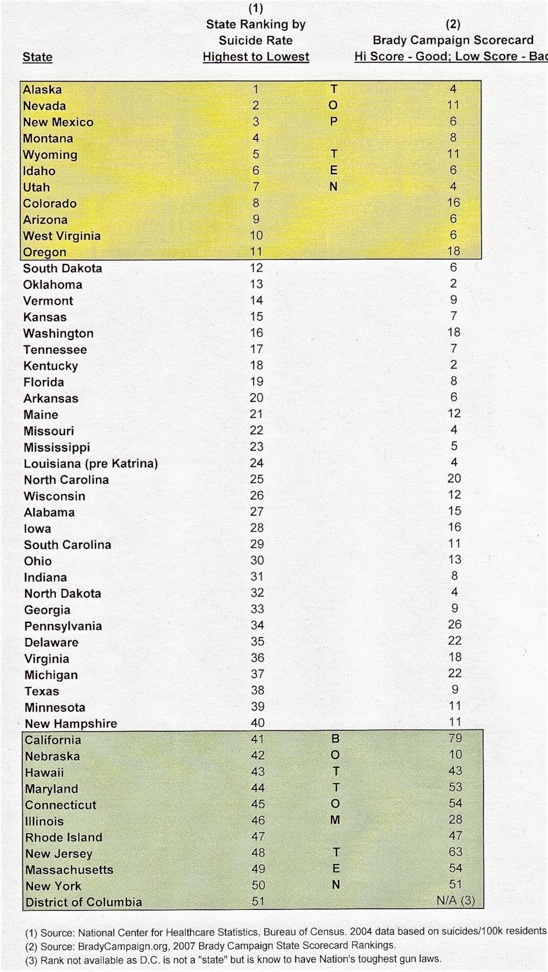
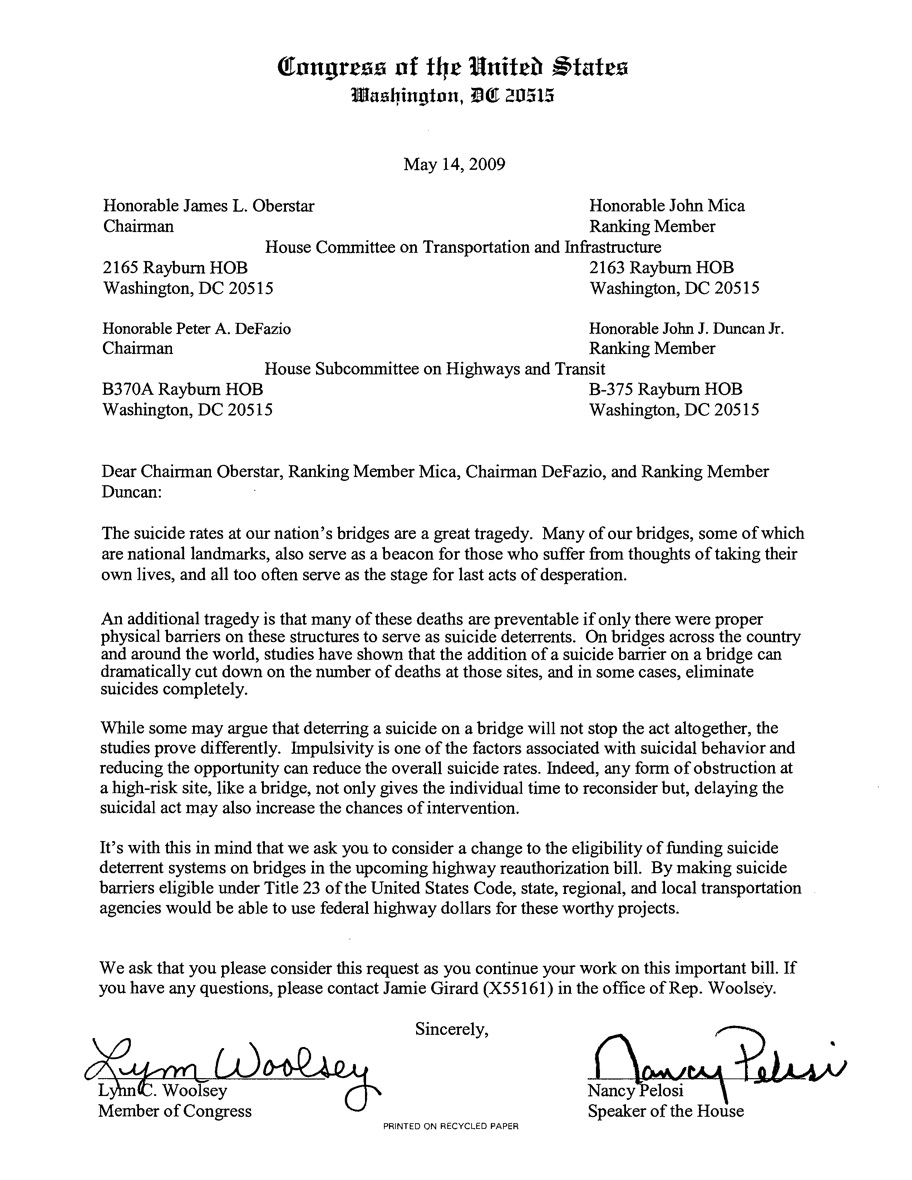
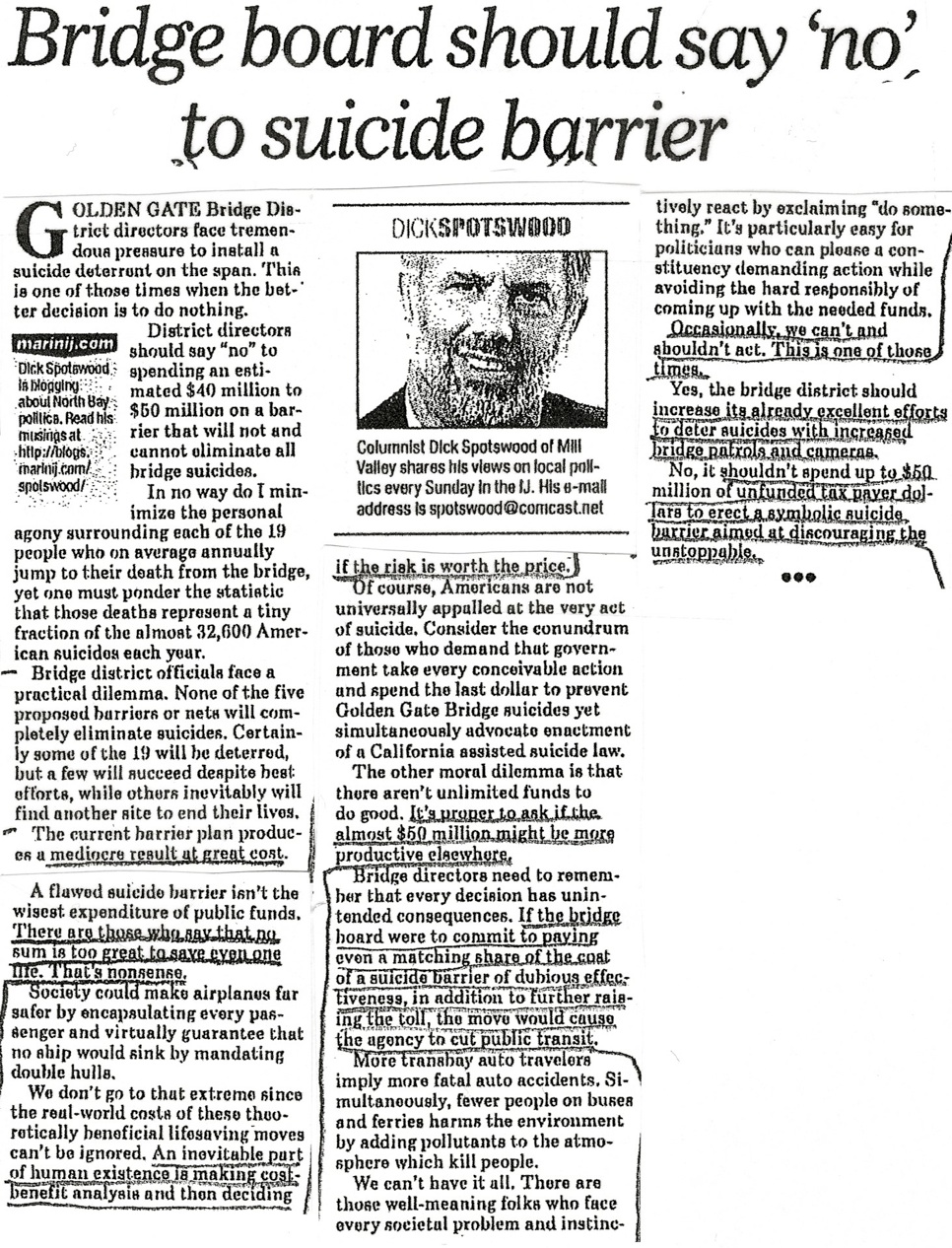
-
*Means restriction is cited by experts as an effective deterrent to suicide. More suicides in the US are by gunshot than by any other means. Seventeen published studies show the rate of suicide death in gun-owning households is at least three times greater than in households where guns are not present. To illustrate, note that states with lax gun laws have the highest suicide rates, and vice versa.
-
*A study conducted by the Washington State DOT of a number of suicide barriers on bridges worldwide indicated a potential positive correlation between suicide barriers and deaths.
Click below to see study:
Download "Barrier Effectiveness"
-
*A study done by the National Suicide Prevention Lifeline came to a similar conclusion as the WA. State study.
Click below to see study:
THIS BLOG WILL BE UPDATED REGULARLY ON OUR PROGRESS, AND WILL PROVIDE FURTHER INFORMATION TO THE PUBLIC ON HOW THEY CAN HELP.
And this is the recommendation to our illustrious Mayor Gavin Newsom who, of course, embraced the recommendation to DO NOTHING before he was actually FOR a barrier. Whoops. That’s a political flip flop of convenience.
Update, August 2009:
Over the course of this summer, the process has been 2 steps forward, one step back.
Forward Steps - In July, the Golden Gate Bridge Board reported that it had completed all steps required to finalize the Environmental Impact Report and Finding of No Significant Impact for the suicide net, including responding to agencies and public comments and executing a Memorandum of Agreement to mitigate the concerns of historic preservationists. Further, the Metropolitan Transportation Commission (“MTC”), the transportation planning, coordinating and financing agency for the San Francisco Bay Area, recently updated its Transportation Improvement Program (“TIP”) by adding into its proposed highway projects the estimated $50 million funding required for the Golden Gate Bridge suicide barrier for fiscal years 2010-2013. This amendment was approved at both the state level (CalTrans) and the federal level (USDOT), subject to obtaining funding.
Backward Step - We have been advised by Congresswoman Woolsey’s office that the re-authorization of the U.S. Highway Bill, scheduled for this fall, has been postponed for up to 18 months due to the multitude of “pressing” matters before Congress, including climate change, the economy and health care. As disappointing as this is, there appears to be little we can do to change it but continue to lobby our Bay Area representatives to do what they can to make this a priority. The letter below is from Congresswoman Jackie Speier explaining the delay.
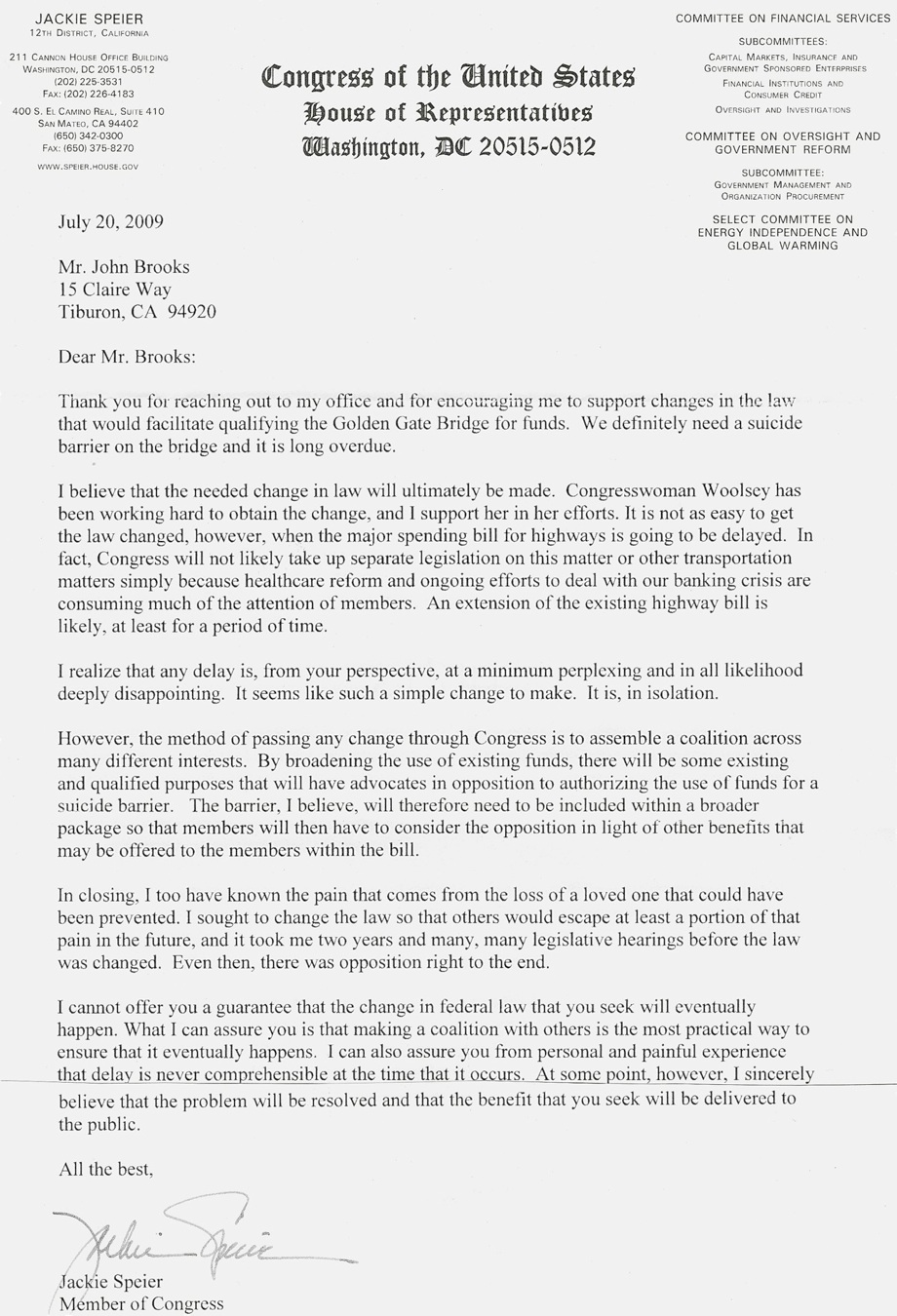
Update, August 2010:
On July 28, 2010. the Metropolitan Transportation Commission, the agency that oversees transportation financing in the Bay Area, voted unanimously to approve the allocation of $5 million of a $15 million federal grant toward engineering and design work required in connection with net deterrent system. The Golden Gate Bridge board of directors also voted unanimously to accept these funds and move the suicide barrier issue forward. Though small in comparison to the $50 million total cost of the project, it is an important psychological boost in that our elected officials - after many years of lobbying - have recognized that a suicide barrier on the bridge can save hundreds of lives and, finally, eliminate the Golden Gate Bridge as the deadliest structure on Earth for suicide.
It is anticipated that the balance of the $50 million cost to complete the project will be provided under the U.S. Highway Bill, but first the Bill needs to be amended so that funds for “suicide deterrent systems” qualify. As indicated above, Congresswoman Lynn Woolsey has drafted an amendment to the Bill when it comes up for re-authorization. Congresswoman Woolsey’s office advises that Congress expects to take up re-authorization of the Bill in 2011. The timing should coincide with completion of pre-construction design phase work currently permitted by the recent $5 million MTC grant.
This important milestone received considerable press coverage nationally as indicated below.
San Francisco Chronicle, City Insider, July 15, 2010
The New York Times, July 29, 2010
TIME.com, August 3, 2010
“Why Is The Bay Area Building a Suicide Barrier”
AolNews.com, July 29, 2010
“Iconic Golden Gate Bridge to Get $45MM Suicide Net”
KCBS-AM/FM, July 28, 2010
“Suicide Barrier Proposal Receives Major Funding”
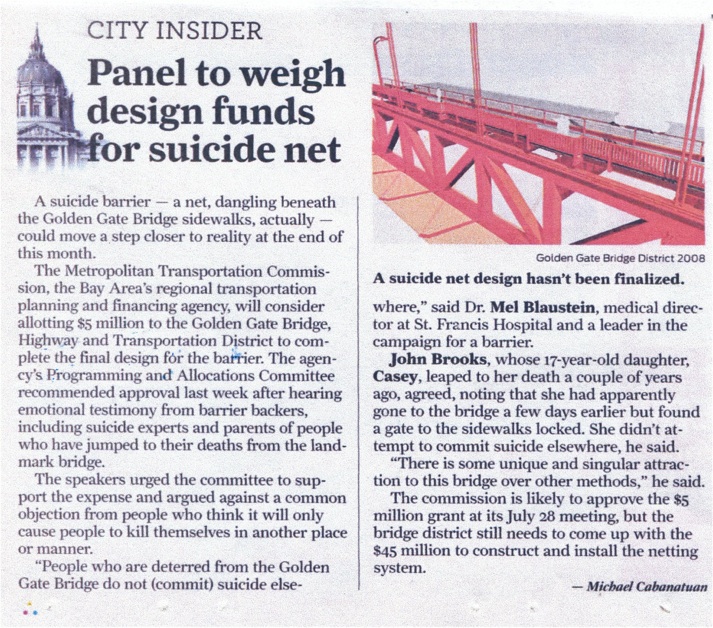
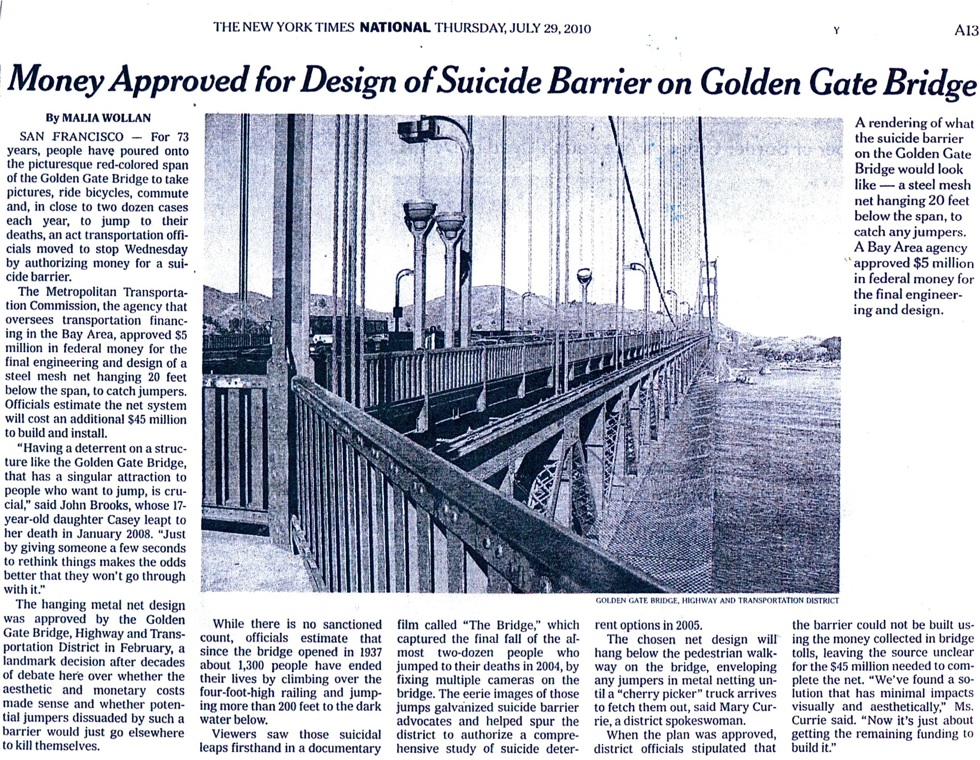
San Francisco Chronicle, Wed. Jan. 5, 2011
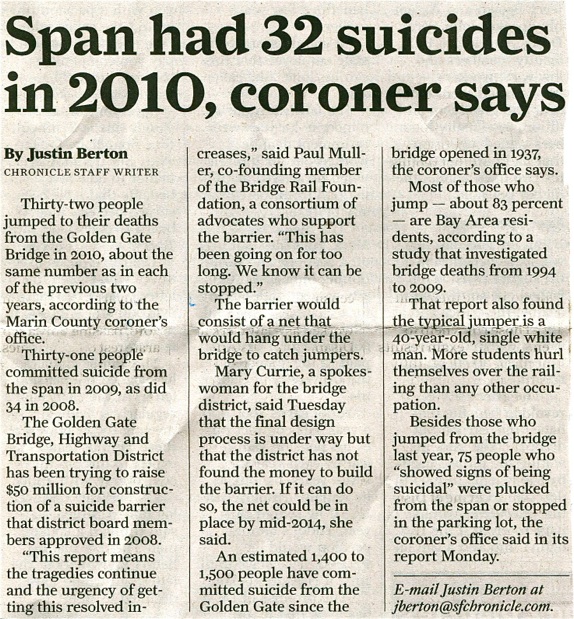
Mill Valley Patch, January 13, 2011
“Ex-Coroner Holmes Continues Quest For Suicide Barrier”
Ken Holmes is one of the true heroes in the battle for a suicide barrier on the Golden Gate Bridge. Up until recently, he worked as the Marin County Coroner, a post he’d held for many years. A more decent and empathetic human being with such a difficult job can never be found. Sadly, despite the evidence to the contrary that suicide deterrents can vastly improve the odds of saving lives, many still stubbornly oppose a barrier due to cost, efficacy and aesthetics, as indicated by the comments posted below the article. People want suicide barriers to be absolutely 100% foolproof. Nothing is foolproof, but if they improve the odds that your loved one might still be alive, isn’t that enough? Or are those lives simply not worth it?

Click here to view video.
Update, September 2011:
Those of us who follow the workings of the Senate Environment and Public Works Committee know that this has become our best hope for a solution to Golden Gate Bridge suicides. Senator Barbara Boxer is the chairman of that committee, which controls the purse strings for infrastructure projects, including roads and bridges. President Obama has made investments in infrastructure a key component of his jobs bill.
In a statement on September 15, 2011, Senator Boxer issued a statement confirming that her committee had extended existing surface transportation authorization bill, SAFETEA-LU, for six months. President Obama is expected to sign off on this extension, which is basically a stopgap for more important legislation - for us. The Senate is continuing to work on a bipartisan proposal, Moving Ahead for Progress in the 21st Century (MAP-21), that will reauthorize surface transportation programs at current funding levels for two years. If all goes according to plan, MAP 21 will contain language that permits the Golden Gate Bridge District to at least apply for funds for the suicide barrier. That’s all we’re asking for. My sources assure me that our local officials and politicians are all over this like white on rice, simply to get the requested language in the bill. Next step is to deal wit the actual money, but we can’t do that until the way is cleared for the “beg” in the first place.
Keeping my fingers crossed.
Update, March, 2012:
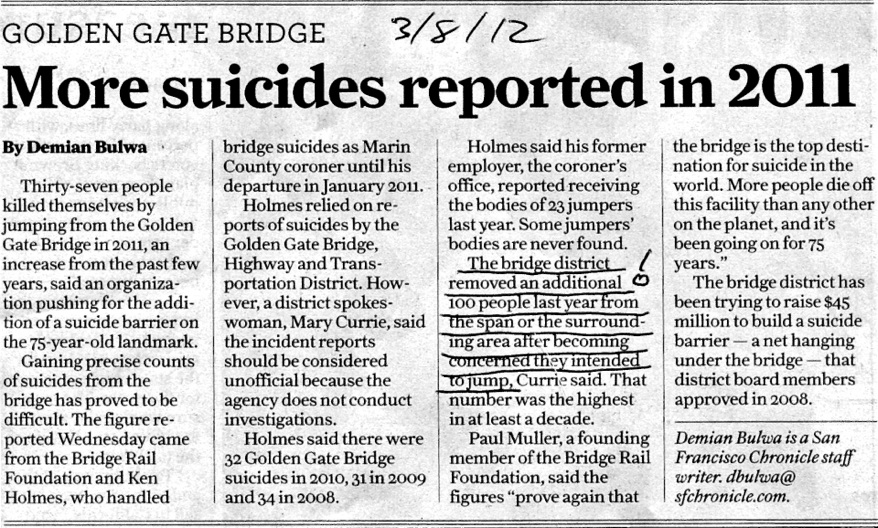
What is most astounding about this article are the “100 people removed from the span over concern they intended to jump.” That means that nearly 140 people went to the Golden Gate Bridge in 2011 with a serious thought of suicide, 37 succeeded. Put another way, every 2-3 days on average someone went to the bridge to die.
San Francisco Chronicle, March, 2012
In March, 2012, Senator Barbara Boxer (D-CA), Chairman of the Senate Infrastructure Committee, worked with arch-conservative Senator James Inhofe (R-OK), a leading climate change denier, to craft a $109 billion, 2 year transportation bill, a major achievement in an era of hyper-partisan-just-say-no-Republicans. Now it goes to the Tea Party House which will surely find a way to kill it. I’ve written to Senator Boxer to thank her for her hard work, but it will probably go for naught.
What
What
Whose Shoes Exhibit At Crissy Field For Golden Gate Bridge 75th Anniversary, May, 2012

Huffington Post, June, 2012
In a rare show of bipartisanship, the House and Senate passed the Transportation Bill. It contains the following provision for safety barriers that will pave the way for the suicide net on the Golden Gate Bridge:
‘‘(7) Highway and transit safety infrastructure improvements and programs, installation of safety barriers and nets on bridges, hazard eliminations, projects to mitigate hazards caused by wildlife, and railway-highway grade crossings.’’
San Jose Mercury News, January, 2013
“Golden Gate Bridge Suicide Rate Holds Steady As Group Pushes For Barrier”
June 27, 2014
Today the Golden Gate Bridge district board of directors voted unanimously for a $76 million funding package from local, state and federal sources for the suicide barrier. It was widely reported in the media. It is estimated that the project could be shovel ready by the beginning of 2015 and take about 3 years to complete. It was a good day but my enthusiasm is somewhat muted because of the fact that construction projects like there are notorious for delays and cost overruns. I think a more realistic time fram is at least 5 years. In my testimony to the board I recommended at least a temporary safety mesh during construction, as was done in the 1930s when the bridge was built. It’d be a cruel iroy to continue to lose lives as efforts are taken to save them.
Stay tuned.
